by Panagioti, Earth First! Newswire
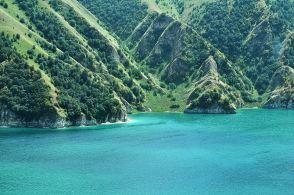
Tired of looking at the same blurry images of the Brothers Tsarnaev? Here’s Lake Kezenoy-am (Chechen: Къоьзаной-Iaм) in Chechnya near border with Dagestan, Russia that goes through Andiyskiy Khrebet (Andian Ridge). Salmo ezenami, a rare species of trout, are native only to the lake; however their population is threatened with extinction.
There a good chance that you are reading this now because of our initial post on the Boston Marathon bombing, “A Tale of Two Terrorisms,” going viral last week, catching the eye of a couple hundred thousand readers (the post was just one short story in an extensive series of articles on drones, repression and the techno-industrial empire). Within a few days it seemed everyone was disturbingly trying to boost their social media hits by referencing Boston, for example the Westboro Baptists claiming it was “God” who brought on the carnage because Massachusetts was the first state to pass same-sex marriage.
By now, I’d guess that you already know more about the alleged young Chechen bombers, the brothers Tsarnaev, than you know about most of your own next door neighbors. But how much have you learned about the Chechen Republic of Ichkeria and what some call “one of the bloodiest occupations of the 21st century”?
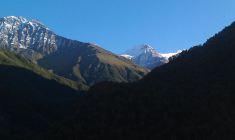
The mountains in the area Sharoi, Chechnya.
Yesterday, an EF! Newswire author hinted at the history: While the US stood as allies behind the Russian Federation’s chauvinism in Chechnya, the landscape was rendered, according to an aid to [Boris] Yeltsin, an “environmental wasteland.” Oil spills, radioactive pollution, and chemical spills resulted from the massive bombardment of Chechnya. Half of Chechnya today is officially considered a “zone of ecological disaster” by the Russian Federation. This may be part of the reason the Tsarnaev Brothers had only spent one year in Chechnya, itself, throughout their entire lives.
While no evidence yet connects the Tsarnaevs to any organized Chechen resistance efforts, and no entity (other than the Westboro Baptists’ god) has claimed the bombing, it seems worthwhile to further understand the social, ecological and historical context of Chechen struggle that this bombing occurred within.
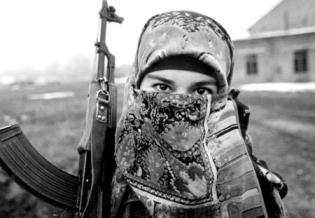
Famous image of a Chechen rebel fighter: “Eyes of fire.. Occupation stokes resistance and fuels terror.” Source, Photo: Heidi Bradner / Panos Pictures
Chechnya, referred to also as Ichkeria (“Land of Minerals”), is a federal subject of Russia located in the southeastern part of Europe in the North Caucasus mountains. Chechens declared sovereignty and independence in 1991 after the collapse of the USSR, but have remained under Russian occupation since 1996, presumably because the region holds a strategic geographic position linking Russia by pipeline and rail to the rich Caspian Sea oilfields.
Much of the following information is from the few English-language Chechen solidarity websites I was able to find.
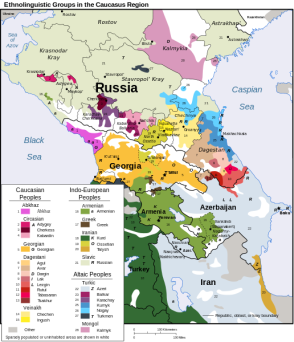
A map depicting the diversity in Ethno-Linguistic groups in the Caucasus region. Check out this link for a list of tribal unions and clans in Chechnya.
The Chechen struggle against the Russian invaders dates back to the late 1700’s. More recently, February 23, 1944, Stalin ordered the deportation of the entire Chechen and Ingush population to Central Asia. More than half of the 500,000 people who were to be forcibly transported died in transit or in massacres committed by Soviet troops.
Since 1994, about 300,000 civilians have been killed, and about 200,000 civilians forced to seek refuge in all over the world. A decade of war and repression has devastated every tier of Chechen Society and killed or displaced approximately a third of the pre-war population.
Leading Human Rights organizations have documented rampant human rights abuses and disappearances of ordinary Chechen men, women and children that are happening on a near daily basis even after the declaration of so-called end for the “anti-terrorist operations” by the colonial Russian Federation in 2009.
Despite this, the European and US political establishments, and much of the mainstream media, continue to ignore the plight of the Chechen people – unless it be to conflate the Chechen struggle with the “War on Terror”.
I’m sure you’ll be shocked to find out that Chechnya’s main mineral wealth is in oil. At the beginning of the last century, commercial oil was only produced in three fields. The Soviet authorities ordered detailed studies to be made of the geological structure of the Grozny oil province, which uncovered a string of new oil deposits.
By 1917 Chechen oil already accounted for 17% of Russia’s entire output of natural petroleum. Today’s oil deposits still amount to about 30 million metric tons. In addition to oil, Chechnya contains significant deposits of natural gas.
In the wake of two wars, peoples’ relation to their land-base has been all but severed, as much of Chechen agricultural land is now riddled with landmines. As for the urban environment, the Kremlin’s appointed regime started a “rebuilding project” estimated at around $300 billion (in contracts to who, one might ask), yet the unemployment rate there today is still at 80-85%. [Source]
In 2006 Human Rights Watch reported that pro-Moscow Chechen forces under the command, in effect, of chapter of republic Ramzan Kadyrov, as well as federal police personnel, used torture to get information about separatist forces. “If you are detained in Chechnya, you face a real and immediate risk of torture. And there is little chance that your torturer will be held accountable,” said Holly Cartner, Director Europe and Central Asia division of HRW.
On July 1, 2009, Amnesty International released a detailed report covering the human rights violations committed by the Russian Federation against Chechen citizens. Among the most prominent features was that those abused had no method of redress against assaults, ranging from kidnapping to torture, while those responsible were never held accountable. This led to the conclusion that Chechnya was being ruled without law, being run into further devastating destabilization.
According to an article in The Guardian on the “unprecedented link” between Chechen rebels and US bombings, it is not something to be ignored or taken lightly:
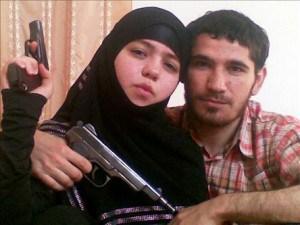
Dzhennet Abdurakhmanova, suspected of being one of two female suicide bombers in the Moscow metro attack in March 2010. On the left her husband, Umalat Magomedo, a Chechen rebel killed by Russian forces in December 2009. Authorities believe the wife staged the attack in revenge for her husband’s death. Source
This call to global jihad may perhaps offer a motive for an attack inside the US. As perhaps were trips back to Caucasus by the two bombing suspects… The main Chechen rebel website, kavkazcenter.com, posts reports from the jihadist movement worldwide: from Syria, where Chechen diaspora fighters are battling government forces in Aleppo, from Pakistan, and from Turkey. [EF!N Note: Clicking this website will likely get your computer's IP address tracked closely by the FBI, if it is not already.]
In the North Caucausus, meanwhile, the Kremlin is carrying out a brutal and rolling counter-insurgency campaign. Its focus is Dagestan, the neighbouring state to Chechnya, and now a hotbed of violent jihadist rebellion. Three weeks ago, Umarov appealed to Chechen fighters abroad to come home to take part in the fight.
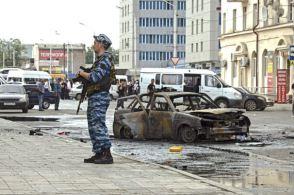
A policeman keeps watch at the site of a suicide bombing in Grozny, the capital of Chechnya, on September 16, 2009. (S. Dal/Reuters)
Cerwyn Moore, an expert on the insurgency in southern Russian insurgency at Birmingham University, said he was surprised it may have spilled over into the US. “It’s a marked change. It seems very odd. There have never been attacks like this outside Russia.” But he added: “You have a group of people who have lived outside Chechnya because of the second Chechen war. This is also an inter-generational thing.”
Odd or not, the Boston bombings play perfectly into the Kremlin’s hands, ahead of Russia’s 2014 Winter Olympics, to be hosted in Sochi, not far from where the current insurgency is raging. It reinforces Putin’s claim – first made in 1999 – that his violent methods are justified to quell a ruthless rebellion by terrorists prepared to take innocent lives.
Another recent article in The Atlantic followed up with this critical insight:
Fear works, and in Russia the Chechen people are cast as the perfect enemy: Islamist radicals who celebrate the 9/11 attacks and pay homage to Al Qaeda. In the next few days, the Putin government will point to the Boston bombings as the result of any and all Chechen opposition to Russian rule.
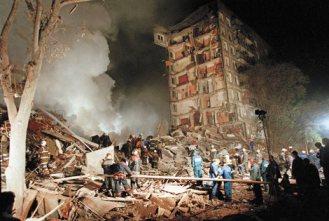
A destroyed apartment building at the site of one of the Moscow bombings, September 9, 1999. Ivan Sekretarev/AP Images.
This has been Putin’s game for the past 15 years. After rising to power in 1999 on a promise to crush Chechen separatists, he exploited a series of terrorist attacks known as the “apartment bombings” to bolster his electoral chances. Almost 300 people died in explosions across three Russian cities. The tumultuous attack was purportedly carried out by Chechen rebels. However, a recently published book about the events by a Stanford University academic indicates that the horrific attack was most likely organized and financed by Putin and his henchmen – to stir up nationalistic fervor, paving the way for the subsequent Russian invasion of Chechnya and cementing his reputation for being “tough on terror.”
In the 2000 elections, Putin ran on a successful platform of restoring national pride and identity, and taking back the former colony of Chechnya was a major talking point. Reopening the Chechen conflict gave him the opportunity to play tough, to show strength, and to exercise his military might while voters cheered for a post-Soviet champion. Even President Bush praised Putin’s “strong hand” against terrorists in Chechnya.
The result is that the world perceives Chechens as troublesome Islamist terrorists, and is willing to accept the thug-like Kadyrov as a bulwark against extremism.
By the time we are posting this story, we’ve found that other news sources (even in the US) are beginning to explore the Chechen context. The tongue-in-cheek Onion seemed to nail it on the head pretty hard:
Our research shows that, while many Americans would like nothing more than to make sweeping, insensitive generalizations about these two individuals based purely on their ethnic identity, this process is largely impeded by the fact that 9 out of 10 Americans truly know next to nothing about Chechnya, including even the very barest details of what or where Chechnya is,” said lead researcher Dr. Tim Kinane, adding that a majority of American citizens are almost totally unaware of Chechen history and culture, how to locate Chechnya on a map, whether Chechnya is a country or a city or a region, or that a person from Chechnya is called a Chechen.
On a final note, those who might think be inclined to paranoia about the Earth First! Newswire becoming a front for islamofascism, rather than recognizing Chechen resistance as an indigenous land struggle, might want to take note of what Foreign Policy had to say about the alleged bombers upbringing as Chechen refugees in Kyrgyzstan:
Although recent years have brought reports of radical Islamist groups operating on a small scale in the south of Kyrgyzstan, they were virtually unknown in any region of Kyrgyzstan when the Tsarnaev family was in the country. They [Tamerlan and Dzhokhar Tsarnaev] were not raised, therefore, in a community where radical Islam was in the air.
————————————–Appreciate this news and analysis? Subscribe or donate to the Earth First! Journal today.
